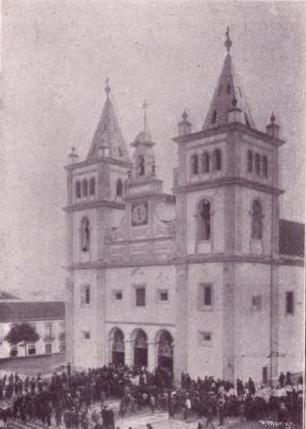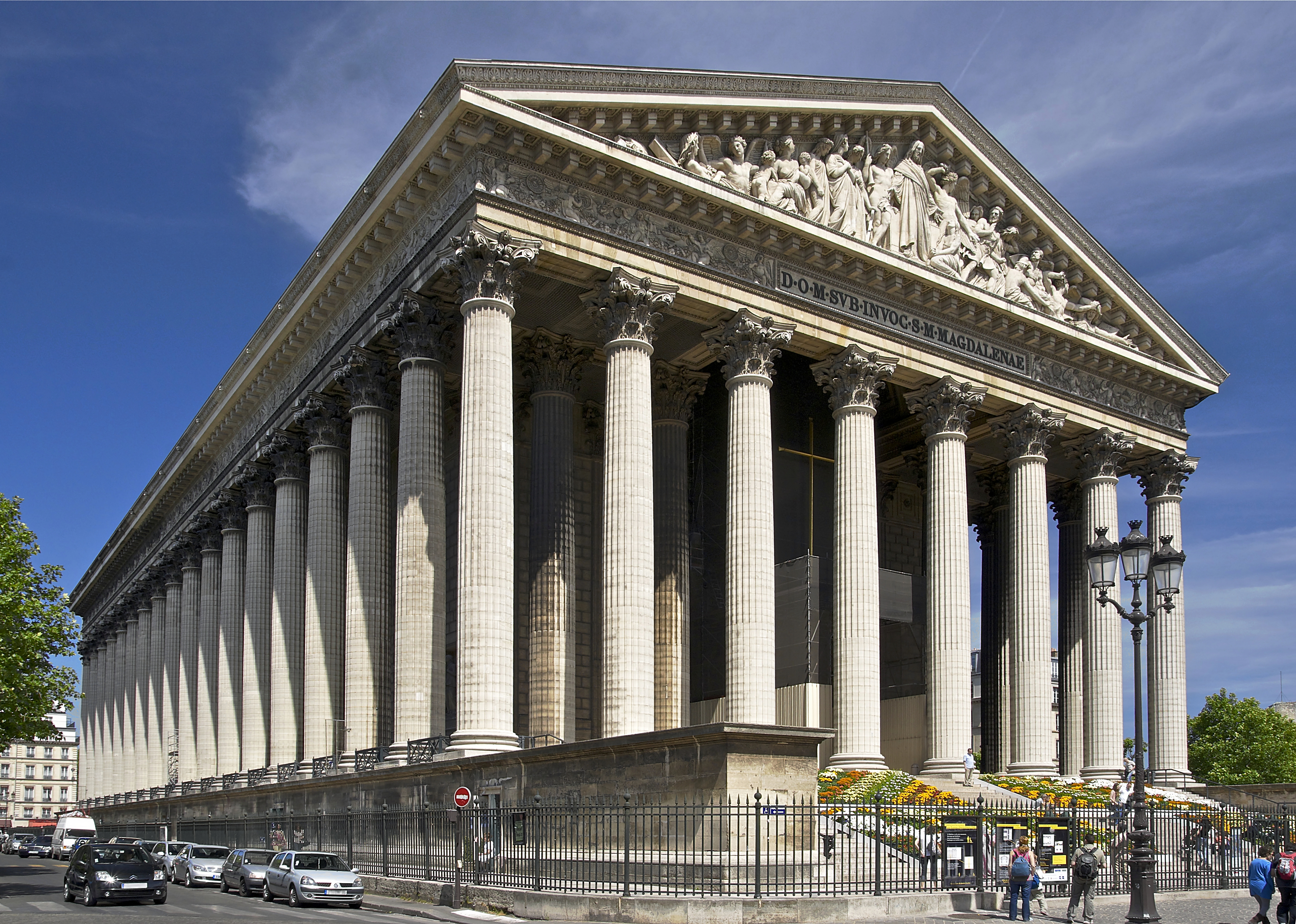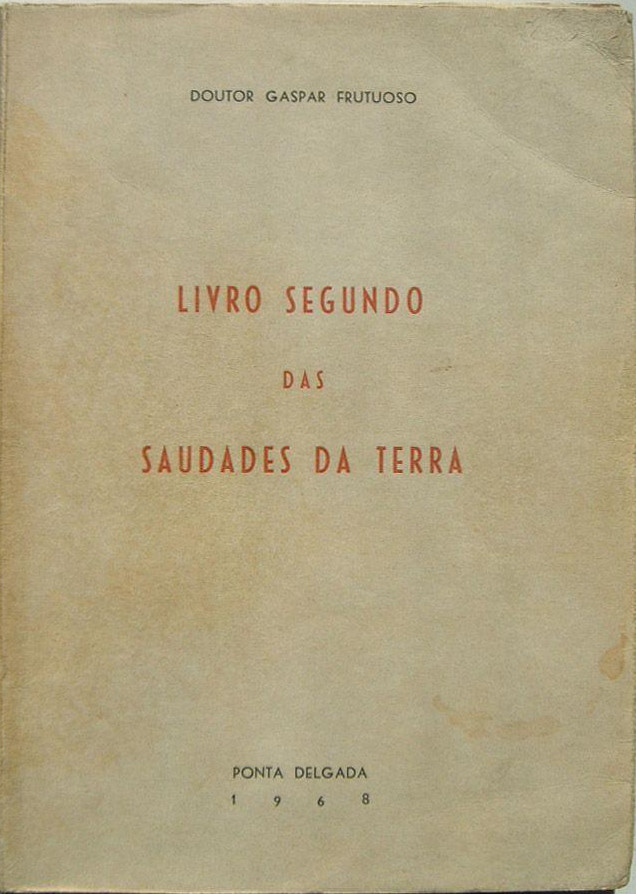|
Church Of Santa Cruz (Lagoa)
The Church of Santa Cruz ( pt, Igreja de Santa Cruz) is a Catholic church situated in the civil parish of Santa Cruz, in the municipality of Lagoa, in the Portuguese archipelago of the Azores. History Sometime in the 15th century, Rodrigo Afonso, who arrived in São Miguel at the beginning of the colonization, accompanying Gonçalo Vaz, instituted the a factory connected to 6.25 acres of land in Pico da Pedra, today known as the lands of Santa Cruz. Gaspar Frutuoso Gaspar Frutuoso (c.1522 in Ponta Delgada – 1591 in Ribeira Grande) was a Portuguese priest, historian and humanist from the island of São Miguel, in the Portuguese archipelago of the Azores. His major contribution to Portuguese history was ..., who served as interim parish priest, between 1558 and 1560, noted that the faith community had started in this territory around 1450. On 25 August 1507, the Bishop of Tangier, D. João Lobo arrived in the Azores by order of D. Diogo Pinheiro (vicar of Tomar), in orde ... [...More Info...] [...Related Items...] OR: [Wikipedia] [Google] [Baidu] |
Lagoa (Azores)
Lagoa (; Portuguese for lagoon) is a municipality in the southwestern part of São Miguel Island in the Azores. The population in 2011 was 14,442, in an area of 45.59 km². Lagoa is located east of Ponta Delgada, the island capital. History The area of Lagoa was settled just after the first colonists came to the island of São Miguel, and its first inhabitants established their homes in the areas that would eventually form the villages of Lagoa and Água de Pau. It is believed that early settlers chose the area for its sheltered bay, which was necessary for their loading and unloading of cargo, livestock and provisions. The Porto dos Carneiros was one of these areas, so named for the fact that sheep, as well as other animals, were offloaded within its cove. The celebrated Portuguese historian, Father Gaspar Frutuoso referred to Lagoa, in the way that the first settlers named it, a name that was dependent on where they made their homes: :''“The village of Lagoa, called this ... [...More Info...] [...Related Items...] OR: [Wikipedia] [Google] [Baidu] |
São Miguel Island
São Miguel Island (; Portuguese for "Saint Michael"), nicknamed "The Green Island" (''Ilha Verde''), is the largest and most populous island in the Portuguese archipelago of the Azores. The island covers and has around 140,000 inhabitants, with 45,000 people residing in Ponta Delgada, the archipelago's largest city. History In 1427, São Miguel became the second of the islands discovered by Gonçalo Velho Cabral to be settled by colonists from continental Portugal. This date is uncertain, as it is believed that the island was discovered between 1426 and 1437 and inscribed in portolans from the middle of the 15th century. Its discovery was later recorded by Father Gaspar Frutuoso in the seminal history of the Azores, ''Saudades da Terra'', as he began: "This island of São Miguel where...we are, is mountainous and covered in ravines, and it was, when we discovered it, covered in trees...due to its humidity, with its water showers and ravines warm with sun..." It was sometime ... [...More Info...] [...Related Items...] OR: [Wikipedia] [Google] [Baidu] |
Azores
) , motto= ( en, "Rather die free than subjected in peace") , anthem=( en, "Anthem of the Azores") , image_map=Locator_map_of_Azores_in_EU.svg , map_alt=Location of the Azores within the European Union , map_caption=Location of the Azores within the European Union , coordinates = , subdivision_type = Country , subdivision_name = , established_title=Settlement , established_date=1432 , established_title3=Autonomous status , established_date3=30 April 1976 , official_languages= Portuguese , demonym= ( en, Azorean) , capital_type=Capitals , capital = Ponta Delgada (executive) Angra do Heroísmo (judicial)Horta (legislative) , largest_city = Ponta Delgada , government_type= Autonomous Region , leader_title1=Representative of the Republic , leader_name1=Pedro Manuel dos Reis Alves Catarino , leader_title2= President of the Legislative Assembly , leader_name2= Luís Garcia , leader_title3= President of the Regional Government , le ... [...More Info...] [...Related Items...] OR: [Wikipedia] [Google] [Baidu] |
Portugal
Portugal, officially the Portuguese Republic, In recognized minority languages of Portugal: :* mwl, República Pertuesa is a country located on the Iberian Peninsula, in Southwestern Europe, and whose territory also includes the Macaronesian archipelagos of the Azores and Madeira. It features the westernmost point in continental Europe, its mainland west and south border with the North Atlantic Ocean and in the north and east, the Portugal-Spain border, constitutes the longest uninterrupted border-line in the European Union. Its archipelagos form two autonomous regions with their own regional governments. On the mainland, Alentejo region occupies the biggest area but is one of the least densely populated regions of Europe. Lisbon is the capital and largest city by population, being also the main spot for tourists alongside Porto, the Algarve and Madeira. One of the oldest countries in Europe, its territory has been continuously settled and fought over since prehistoric tim ... [...More Info...] [...Related Items...] OR: [Wikipedia] [Google] [Baidu] |
Roman Catholic Diocese Of Angra
The Roman Catholic diocese of Angra ( pt, Diocese de Angra, la, Dioecesis Angrensis) is a Roman Catholic diocese comprising the Portuguese archipelago of the Azores. The see is located in Angra do Heroísmo, in the Terceira island. The current Ordinary is Armando Esteves Domingues. History The Azores, like all the islands and lands discovered during the Portuguese Age of Discoveries, began as jurisdictions of the Order of Christ, under the direction of the vicar of Tomar ( la, vicarius nullius). Upon the creation of the Bishopric of Funchal, in 1514, the communities of the Azores began to fall within the jurisdiction of the Bishop of Funchal. As the result of a petition by King John III of Portugal, Pope Clement VII created the Bishopric of São Miguel (São Salvador), but this patriarch died (31 January 1533) before a Papal bull was issued. The request to Clement VII included the creation of two new Dioceses, one for the islands of the Azores and the other for the settlemen ... [...More Info...] [...Related Items...] OR: [Wikipedia] [Google] [Baidu] |
Roman Catholic
Roman or Romans most often refers to: *Rome, the capital city of Italy *Ancient Rome, Roman civilization from 8th century BC to 5th century AD *Roman people, the people of ancient Rome *''Epistle to the Romans'', shortened to ''Romans'', a letter in the New Testament of the Christian Bible Roman or Romans may also refer to: Arts and entertainment Music *Romans (band), a Japanese pop group * ''Roman'' (album), by Sound Horizon, 2006 * ''Roman'' (EP), by Teen Top, 2011 *"Roman (My Dear Boy)", a 2004 single by Morning Musume Film and television *Film Roman, an American animation studio * ''Roman'' (film), a 2006 American suspense-horror film * ''Romans'' (2013 film), an Indian Malayalam comedy film * ''Romans'' (2017 film), a British drama film * ''The Romans'' (''Doctor Who''), a serial in British TV series People * Roman (given name), a given name, including a list of people and fictional characters * Roman (surname), including a list of people named Roman or Romans *Ῥωμα� ... [...More Info...] [...Related Items...] OR: [Wikipedia] [Google] [Baidu] |
Baroque Architecture
Baroque architecture is a highly decorative and theatrical style which appeared in Italy in the early 17th century and gradually spread across Europe. It was originally introduced by the Catholic Church, particularly by the Jesuits, as a means to combat the Reformation and the Protestant church with a new architecture that inspired surprise and awe. It reached its peak in the High Baroque (1625–1675), when it was used in churches and palaces in Italy, Spain, Portugal, France, Bavaria and Austria. In the Late Baroque period (1675–1750), it reached as far as Russia and the Spanish and Portuguese colonies in Latin America. About 1730, an even more elaborately decorative variant called Rococo appeared and flourished in Central Europe. Baroque architects took the basic elements of Renaissance architecture, including domes and colonnades, and made them higher, grander, more decorated, and more dramatic. The interior effects were often achieved with the use of '' quadratura ... [...More Info...] [...Related Items...] OR: [Wikipedia] [Google] [Baidu] |
Church (building)
A church, church building or church house is a building used for Christian worship services and other Christian religious activities. The earliest identified Christian church is a house church founded between 233 and 256. From the 11th through the 14th centuries, there was a wave of church construction in Western Europe. Sometimes, the word ''church'' is used by analogy for the buildings of other religions. ''Church'' is also used to describe the Christian religious community as a whole, or a body or an assembly of Christian believers around the world. In traditional Christian architecture, the plan view of a church often forms a Christian cross; the center aisle and seating representing the vertical beam with the bema and altar forming the horizontal. Towers or domes may inspire contemplation of the heavens. Modern churches have a variety of architectural styles and layouts. Some buildings designed for other purposes have been converted to churches, while many ori ... [...More Info...] [...Related Items...] OR: [Wikipedia] [Google] [Baidu] |
Freguesia (Portugal)
''Freguesia'' (), usually translated as "parish" or "civil parish", is the third-level administrative subdivision of Portugal, as defined by the 1976 Constitution. It is also the designation for local government jurisdictions in the former Portuguese overseas territories of Cape Verde and Macau (until 2001). In the past, was also an administrative division of the other Portuguese overseas territories. The '' parroquia'' in the Spanish autonomous communities of Galicia and Asturias is similar to a ''freguesia''. A ''freguesia'' is a subdivision of a '' município'' (municipality). Most often, a parish takes the name of its seat, which is usually the most important (or the single) human agglomeration within its area, which can be a neighbourhood or city district, a group of hamlets, a village, a town or an entire city. In cases where the seat is itself divided into more than one parish, each one takes the name of a landmark within its area or of the patron saint from the usually ... [...More Info...] [...Related Items...] OR: [Wikipedia] [Google] [Baidu] |
Santa Cruz (Lagoa)
Santa Cruz ( Portuguese for Holy Cross Holy Cross or Saint Cross may refer to: * the instrument of the crucifixion of Jesus * Christian cross, a frequently used religious symbol of Christianity * True Cross, supposed remnants of the actual cross upon which Jesus was crucified * Feast ...) is a parish in the municipality of Lagoa in the Azores. The population in 2011 was 3,671, in an area of 14.27 km². It contains the localities Cabo da Vila and Remédios. References {{authority control Parishes of Lagoa, Azores ... [...More Info...] [...Related Items...] OR: [Wikipedia] [Google] [Baidu] |
Concelho
Concelho () is the Portuguese-language term for municipality, referring to the territorial subdivision in local government. In comparison, the word ''município'' () refers to the organs of State. This differentiation is still in use in Portugal and some of its former overseas provinces, but is no longer in use in Brazil following the abolition of these organs, in favour of the French prefecture system. It is similar to borough A borough is an administrative division in various English-speaking countries. In principle, the term ''borough'' designates a self-governing walled town, although in practice, official use of the term varies widely. History In the Middle ... and council. History After the civil parish ( pt, freguesias), the Portuguese ''concelho'' is the most stable territorial subdivision within the country, with over 900 years of history. Founded in the royal charters attributed to parcels and territorial enclaves, in order to establish a presence by the Cr ... [...More Info...] [...Related Items...] OR: [Wikipedia] [Google] [Baidu] |
Gaspar Frutuoso
Gaspar Frutuoso (c.1522 in Ponta Delgada – 1591 in Ribeira Grande) was a Portuguese priest, historian and humanist from the island of São Miguel, in the Portuguese archipelago of the Azores. His major contribution to Portuguese history was his detailed descriptions of the history and geography of the Azores, Madeira, Canary Islands and references to Cape Verde, which he published in his six-part tome '' Saudades da Terra'', as well as ''Saudades do Céu''. He is normally cited in settlement history of the islands of the Azores. Biography Gaspar Frutuoso was born in 1522,José Luís Brandão da Luz (1996), p. 475 on the island of São Miguel, son of Frutuoso Dias, a merchant and rural property-owner, and his wife Isabel Fernandes. Little is known of his childhood, apart from references to him working his father's lands during this period. The first trustworthy record about Frutuoso was his admission to the University of Salamanca (in 1548) where he later obtained an Arts ... [...More Info...] [...Related Items...] OR: [Wikipedia] [Google] [Baidu] |




